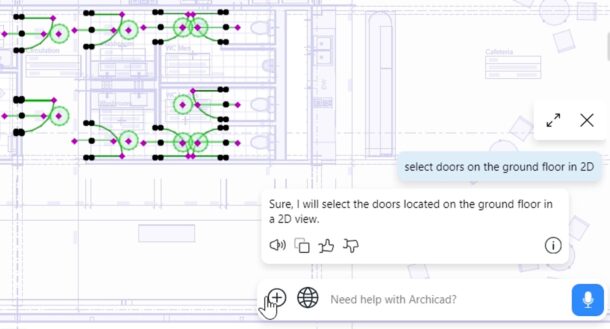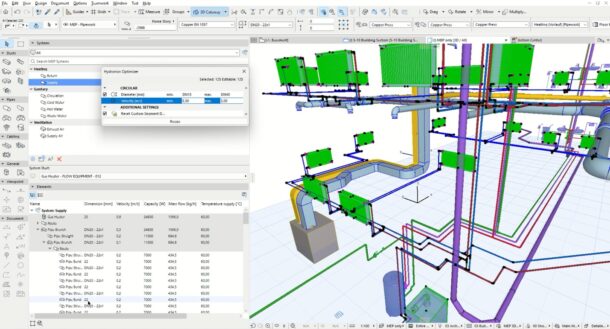Nemetschek’s subsidiary Graphisoft unveiled a major strategy direction around what the company is calling Design Intelligence last week at AIA25 Boston. The national convention of the American Institute of Architects (AIA) and expo was an ideal spot for the Budapest-headquartered BIM innovation leader to take the curtain off its AI and data-centric product strategies. The company has its US-based headquarters in the metro Boston region.
While Graphisoft had several different aspects to showcase at AIA25 Boston, perhaps the most interesting was its Project Aurora initiative, which we will delve into first.
Project Aurora
Project Aurora is primarily Graphisoft’s response to the BIM 2.0 evolution. We described and defined BIM 2.0 in our introductory article earlier this week, but we can summarize here that BIM 2.0 platform and app technologies are fundamentally cloud-native, in contrast to the desktop-based tools of the BIM 1.0 era.

A preview image of Project Aurora, Graphisoft’s new cloud-native tool under development that will address Design Optimization.
Aurora is cloud-native, data-centric, and focused on many of the same aspects that BIM 2.0 startups in the industry are interested in, including the initial one from Scandinavia that Autodesk acquired, Spacemaker.AI. We know that tool today as Autodesk Forma. Unlike Forma, however, Graphisoft’s Aurora is being architected from the beginning to connect directly to its popular BIM authoring platform, Archicad.
Project Aurora is focused on helping architects evaluate potential building sites, optimizing space planning, studying massing and human experience design, and more. It also addresses sustainability by analyzing materials and their energy and carbon components of design.
Márton Kiss, Chief Product Officer at Graphisoft had this to say about it in a press release:
The past two decades have seen BIM and digitalization revolutionize our industry. But as demands increase, traditional tools alone aren’t enough.
He continues: “Our Design Intelligence Strategy integrates AI, data-driven insights, and advanced workflows—empowering architects and engineers to make informed decisions at every project stage — resulting in better-performing, more sustainable buildings. The benefit to our users is nothing less than enhanced creativity, productivity, and a growing portfolio of winning projects.”
AI and Data-Centric Design
Graphisoft was there to talk about its upcoming fall 2025 annual release. Aurora will come as an alpha in Q3 of 2025 and a full beta in 2026, so the fall release for the Hungary-based BIM leader will include other new aspects like its AI Assistant and new Graphisoft MEP Designer.
The Nemetschek Group has a dedicated and centralized AI team and strategy. AI Visualizer has been the most visible component of that team and is now part of all three Group BIM authoring tools. The next item on tap appears to be some form of a unified approach to an AI Assistant. The fall 2025 release of Archicad will include the first integration of the AI Assistant which in Archicad’s case will go further than the initial AI assistant technology now part of sister BIM solution Vectorworks. The AI Assistant in Archicad will help users streamline repetitive tasks and speed up documentation. It will, of course, also help users learn and master the BIM authoring solution much the same as what is happening now with its sister brand BIM.
Also on tap for the fall 2025 update will be enhancements to BIMx and BIMcloud, two award-winning applications and technology stacks that have both revolutionized the entire industry setting a very high bar for others in the industry to match.
Graphisoft MEP Designer
Graphisoft has long had an MEP modeler which would help architects and engineers model ductwork, but the MEP Designer is entirely new technology. Because close collaboration between MEP engineers and architects is so crucial in BIM in the era of sustainable design, it was time for the company to upgrade their solution in this area.
MEP Designer is fully integrated within Archicad. It is deliberately built to help streamline the workflows between architects and MEP engineers and draftsmen. With powerful intuitive modeling tools, automated system design, and a built-in energy analysis tool set, Graphisoft’s new MEP Designer offers its more sophisticated users a powerful new set of capabilities. MEP Designer will be available to all Archicad Collaborate subscribers.
We will have more to say about Graphisoft in other AIA25 Boston reports coming up.
To learn more visit Graphisoft online.




